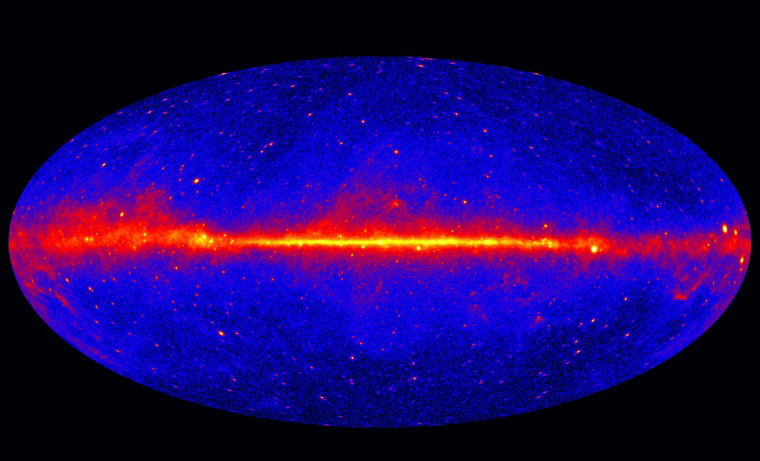Researchers from Johns Hopkins using powerful supercomputer simulations have determined that the most likely explanation for a mysterious glow at the center of the Milky Way Galaxy involves collisions of dark matter, resulting in gamma ray emissions that cause the mysterious, diffuse glow.
While the simulations also suggest the phenomenon could be caused by spinning pulsars, the data best support the dark matter theory. If correct, the discovery could offer the first unequivocal proof of dark matter’s existence and provide scientists with a new approach to studying the enigmatic material that makes up a large portion of the universe’s mass.
“Our key new result is that dark matter fits the gamma ray data at least as well as the rival neutron star hypothesis,” the study’s lead author, Joseph Silk, a professor of physics and astronomy at Johns Hopkins and a researcher at the Institut d’Astrophysique de Paris and Sorbonne University, told The Debrief. “We have increased the odds that dark matter has been indirectly detected.”
Since the Fermi satellite, launched in 2008, first discovered the mysterious glow at the center of the Milky Way, several explanations have been proposed to explain its origin. The most promising theories propose that the light comes from either collisions of dark matter particles or from quickly spinning neutron stars.
While the second concept involves proven phenomena, the possibility that the glow is caused by dark matter is particularly intriguing to scientists. This is because dark matter itself is still purely theoretical and lacks definitive proof, as it does not interact with light and therefore cannot be “seen.” Instead, scientists have had to infer dark matter’s existence from its gravitational effects on ordinary matter, while continuing to explore new ways to prove its existence.
In a statement detailing the team‘s research, explained that dark matter “dominates the universe and holds galaxies together,” making its detection a major scientific priority for decades.
“It’s extremely consequential, and we’re desperately thinking all the time of ideas as to how we could detect it,” Professor Silk explained. “Gamma rays, and specifically the excess light we’re observing at the center of our galaxy, could be our first clue.”
In a series of simulations, the professor and an international research team used several supercomputers to create virtual “maps” of locations within the Milky Way that current theories predict dark matter to be located. The team notes that their simulations took into account how the galaxy was formed “for the first time in history,” resulting in an unprecedented level of detail in the final maps.
This critical component of the simulations involved modeling the movement of dark matter during the first billion years of the Milky Way’s existence. The research team said that’s because galactic formation theories predict that many smaller galaxy-like systems entered the Milky Way and became its “building blocks.” During this phase, dark matter particles gravitate toward the center of the galaxy and form clusters. This clustering would result in higher numbers of dark matter collisions, which could, in theory, produce the mysterious glow that still exists today.
According to the team’s statement, when they factored in “more realistic” dark matter collisions, their simulations produced maps that matched actual gamma ray maps previously captured by the Fermi Gamma-ray Space Telescope. The team said the matching simulated and real-world maps “round out a triad of evidence” supporting dark matter collisions as the cause of the mysterious glow at the center of the Milky Way Galaxy.
“Gamma rays coming from dark matter particle collisions would produce the same signal and have the same properties as those observed in the real world,” they explain, “though it’s not definitive proof.”
A second scenario considered in the team’s study involves reinvigorated, old, rapidly spinning neutron stars, known as millisecond pulsars, which could emit the gamma rays. Still, the team notes that the theory is “imperfect,” since their simulations would have to assume there are more millisecond pulsars than have been previously observed in the real world. Conversely, the dark matter collision simulated maps accurately match the real-world observations.
Up next, Professor Silk’s team is preparing follow-up experiments that could determine if the gamma rays causing the mysterious glow at the center of the Milky Way are high-energy rays or low-energy rays. If the experiments show the glow is composed of high-energy rays, the finding would support the millisecond pulsars as its cause. However, Silk notes, if the gamma rays turn out to be low-energy rays caused by dark matter collisions, it would be the first direct evidence for the existence of dark matter ever discovered.
“A clean signal would be a smoking gun, in my opinion,” the professor said.
The team said that figuring out when they will be able to perform these experiments may depend on the completion of the “huge” Cherenkov Telescope Array (CTA). Currently in the construction phase, the array is specifically designed to detect gamma rays of varying energies.
“The Cherenkov Telescope Array under construction in Chile is expected to be the first to provide the necessary sensitivity to test our dark matter hypothesis,” Professor Silk told The Debrief.
While awaiting the observatory’s completion, the team is already working on predictions on potential dark matter clusters within several dwarf galaxies that currently circle the Milky Way. Once the high-res data from Cherenkov is available and compared to the prediction maps, the professor said the team may find the proof of dark matter they are hoping for or support for the millisecond pulsar concept.
“Two possibilities are being considered,” the professor told The Debrief. “One is to look at the Galactic center excess at higher energies. The dark matter hypothesis has no signal because gamma ray energies are limited by the mass of the colliding particles.”
Conversely, the professor said that’s not the case with millisecond pulsars. He also pointed out that the new array will be capable of studying several nearby dwarf galaxies that are “known to consist mostly of dark matter.”
“Detecting the same signal Fermi found for the galactic center would confirm the DM hypothesis,” Silk told The Debrief.
Of course, given the unknown nature of dark matter and the mysterious nature of the galactic glow coming from the center of the Milky Way, the professor conceded that the results may hint at a cause they hadn’t even considered.
“It’s possible we will see the new data and confirm one theory over the other,” Silk explained. “Or maybe we’ll find nothing, in which case it’ll be an even greater mystery to resolve.”
The study, “Fermi-LAT Galactic Center Excess morphology of dark matter in simulations of the Milky Way galaxy,” was published in Physical Review Letters.
Christopher Plain is a Science Fiction and Fantasy novelist and Head Science Writer at The Debrief. Follow and connect with him on X, learn about his books at plainfiction.com, or email him directly at christopher@thedebrief.org.


